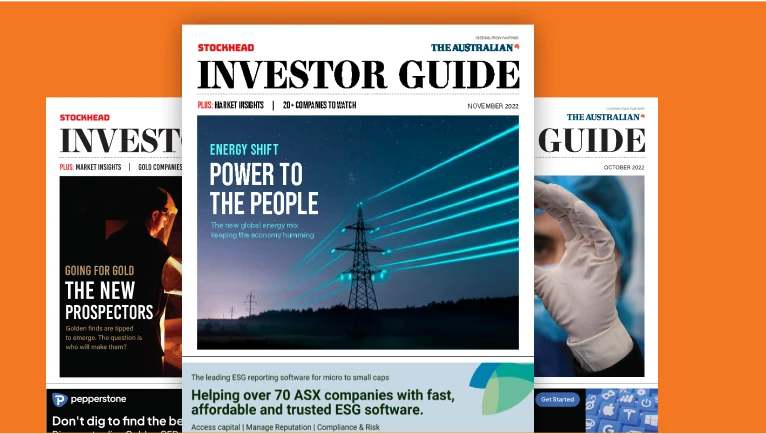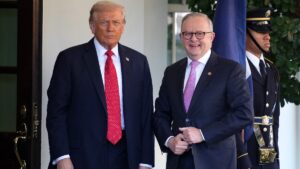Critical minerals are all the rage, but is the optimism reflected in miners’ performance?

How would you rate retail faves LYC, MIN and IGO's quarters? Pic: Getty Images
- Three of the ASX’s biggest critical and battery metals stocks reported on a bumper Thursday
- Mineral Resources surged after letting the numbers talk for its Onslow Iron mine, and on higher lithium pricing
- Lynas boss Amanda Lacaze sees strong demand for company’s heavy rare earths
There have been few commodities – sans gold and silver – drawing the sort of investor interest seen in so-called ‘critical minerals’ in recent weeks.
Chief among them have been rare earths and, to some extent, a recovering lithium, as investors begin to look to the future beyond the price crashes that hobbled miners in the field in 2023 and 2024.
Three of them were on the reporting radar yesterday – the West’s top rare earths producer Lynas (ASX:LYC), iron ore and lithium miner Mineral Resources (ASX:MIN) and Greenbushes minority owner IGO (ASX:IGO).
Mainstream attention has driven enthusiasm for stocks in the arena in the past few months, but is goodwill being reflected in profitability?
It’s a mixed bag.
Lynas has come down 20% in the past month as the US-Australia critical minerals deal failed to put the miner and refiner of rare earth materials front and centre in a US$8.5bn trade deal.
That said, it has announced deals with Korean and American magnet makers to develop ex-China supply chains for permanent magnets and announced a $180m heavy rare earths plant in Malaysia, funded by the proceeds of a recent $750m placement and oversubscribed $182m share purchase plan.
Lynas lifted cash in bank from $166.4m to $1.06bn between June 30 and September 30, largely due to the placement, though it did lift revenue from $170.2m to $200.2m QoQ, with rare earth production rising from 3212t in Q4 2025 to 3993t (2003t higher value NdPr) in Q1 FY26. NdPr sales were a record, Lynas reported, though the average sales price of its basket fell from $60.2/kg to $54.3/kg, still up from $42.5/kg a year earlier.
A caveat – its results came right before Donald Trump claimed to have sorted out an impasse on rare earth supplies from China in typically unclear fashion after his in-person meeting with Xi Jinping in Korea.
Over at MinRes, Chris Ellison’s miner beat consensus on iron ore sales and pricing, with spodumene pricing also up 31% in a positive start to FY26 as it looks to deleverage its balance sheet – $5.4bn net debt at September 30. Shares ripped 14% higher.
And IGO reported a 293% lift in underlying EBITDA to $19.3m with cash up 2% to $286.5m, but it was impacted by lower production at the Greenbushes lithium mine and Nova nickel-copper mine.
Let’s check out the key talking points from around the grounds as bosses at the three big miners fronted investors and analysts yesterday.
Setting the goalposts in rare earths
Much of the focus from the Lynas quarterly call fell onto the strategic movements in the critical minerals market.
After producing dysprosium and terbium oxides for sale to customers in recent months and announcing plans to develop a full scale plant in Malaysia on Wednesday, Lynas MD Amanda Lacaze said the company was seeing strong demand for heavy rare earths.
It comes after China made the metals the key focus of rare earth export controls issued in April and October this year.
While China dominate the rare earths market more generally, it has near total control when it comes to heavy rare earth elements.
“In terms of testing the market we have identified extremely strong demand and we have also identified a preparedness to pay because of the scarcity of material from outside China sources,” Lacaze said.
“And that is the reason why it is the first of our Towards 2030 projects we will be bringing online which is the full scale HREE separation facility.”
Lacaze said Lynas has estimated the dysprosium market at around 400t outside China, with the miner soon able to bundle Dy with other products it sells to magnet makers and OEMs.
The new plant will eventually process 250t Dy and 50t terbium a year, along with other heavies like samarium (1100tpa), a key ingredient in samarium-cobalt batteries.
While volumes are too small right now to meaningfully impact the average selling price reported by Lynas, Lacaze said the company had good flexibility to decide which customers it sold to and at what price.
Although higher NdPr pricing isn’t reflected yet in Lynas’ accounts, Lacaze believes the market should view the US$110/kg NdPr floor price included in a deal between the Pentagon and US producer MP Materials as a reference price. Analysts from Argonaut continue to think Lynas shares are pricing in NdPr well above not just the market price, but also the MP floor price, labelling the $15bn company a sell.
Argonaut has a $9.50 price target, though Canaccord maintained a hold and lifted its price target from $13.70 to $14.15. Canaccord’s Reg Spencer thinks Lynas could command ~7% of the heavy rare earths market from 2027 against today’s +97% China controlled supply chain.
Lacaze said governments are working to prevent market failure, saying the MP deal sets “the goalposts, not the height”.
Despite the announcement of investments in new capacity, including government funding announced as part of the US-Australia trade deal, Lacaze poo-pooed suggestions there could be a flood of material, saying she’d be surprised if there was anything of substance before the end of 2027 brought to market.
Iluka Resources is the most advanced. Its Eneabba Refinery in WA is due for completion within a couple years, helped by a ~$1.7bn loan from the Australian Government.
Arafura Rare Earths (ASX:ARU) meanwhile completed a $475m equity raise that will give Gina Rinehart’s Hancock Prospecting a 15.7% stake in the owner of the Nolans rare earth project, as it targets equity to support over $1bn in international governmental financing for the NT mine.
Lacaze said it was ‘incumbent’ on Western governments to protect the current ex-China supply chain, with Lynas at its centre, as it builds out the magnet and metals manufacturing industries to compete with the Middle Kingdom.
MinRes back from the brink?
Now onto lithium and iron ore, where investors are betting MinRes has turned a corner after dramatically increasing its spodumene pricing from the Mt Marion and Wodgina mines, and critically hit a 35Mtpa run rate at the Onslow Iron project in the Pilbara.
Speculation has been rife on its capacity to hit nameplate, with a series of haul road issues prompting a full sealing of the path from the Ken’s Bore mine to the Onslow port earlier this year.
It’s now received a $200m payment from Morgan Stanley contingent on hitting that runrate for three months, maintaining FY26 guidance of 30-33Mt after shipping 8.6Mt on a 100% basis in the September quarter.
That clocked in at a cost of $54/wmt, at the lower end of guidance, with production from the Pilbara hub of 2.7Mwmt at $83/wmt.
Attributable (50%) spodumene production at Wodgina clocked in at 88,000dmt and at 55,000dmt at Mt Marion on a SC6 basis, well ahead of guidance, with strong cost performance of $733/dmt SC6 and $796/dmt SC6 respectively.
Pricing lifting 31% QoQ to US$849/dmt SC6.
With the iron ore operations apparently on a more solid footing – and expansion to as much as 38Mtpa potentially on the cards at Onslow Iron with the delivery of a 6th transshipper later this financial year – analysts are getting more optimistic.
Argonaut lifted its price target from $54 to $60, while RBC, Barrenjoey and Morgan Stanley all have their own versions of outperform on the stock.
With net debt steady at $5.4bn, $1.1bn in liquidity, the JV partner loan for Onslow starting to be paid down and $41m delivered through the close off of the sale of MinRes energy assets to Hancock Energy, CFO Mark Wilson said there was no need to sell down the lithium assets even if “inorganic deleveraging” was on the table.
“You should assume that anything we do on any of the assets we will only transact if we see real value there. So we don’t need to do a transaction today. We’re really pleased with the way the business is performing,” he said.
“We’re pleased with the cash it’s generating. We can see that –as I said earlier – that clear line of sight to de-leveraging through the performance of the business.
“Just to emphasise, we won’t do anything unless we can see very strong value, both financial and strategic, for doing something.”
IGO looks to shake off discount
It’s been a rough ride for IGO, which has been hit by a tornado of weak lithium prices, a nickel market meltdown and stuttering lithium hydroxide refinery in recent years.
How investors must wish they still had some gold.
Spodumene sales and production at Greenbushes were hit 27% and 6% respectively QoQ to 301,000t and 320,000t – IGO has a 24.9% stake and collected $50m in the form of a dividend from the mine’s holding company in the September quarter.
Cash costs lifted 6% to $388/t against average sale prices of $730/t.
On the plus side capex fell 26% to $121m. Talison, which runs the mine, is getting hit by lower grades and South-West WA’s wet winter, but there is sunlight on the horizon with the CGP3 expansion due to deliver first ore at the end of the year.
There was some brighter news for the ill-fated refinery JV with Tianqi in Kwinana, with production up 31% to 2775 t of lithium hydroxide and sales up 68% to 2921t.
Production levels remain just 46% of nameplate for the first “24,000tpa” train.
Costs fell 18% to $14,177/t, with IGO already having fully impaired its stake in the asset.
IGO boss Ivan Vella told analysts he can’t give a timeline on the resolution of the JV structure with Tianqi, which operates the refinery held in the 51-49 TLEA JV through which the partners also maintain their Greenbushes stake.
MST’s Matthew Frydman suggested on the call that a lack of control over the Greenbushes asset had led IGO to be discounted against lithium peers, despite having a stake in the best lithium mine on the planet.
“I can’t give you a timeframe or a date for that … we expect as that’s resolve that will unlock some of the discount or some of the anxiety that probably sits around the potential of Greenbushes,” he said.
But Vella said to expect the lithium price to remain at current levels forever was “probably not realistic”.
“Naturally when you’re in that low ebb, those negatives are amplified. I can imagine that the price moves, the cash is flowing, things look very different because this (Greenbushes) is a very highly leveraged asset.”
Related Topics

UNLOCK INSIGHTS
Discover the untold stories of emerging ASX stocks.
Daily news and expert analysis, it's free to subscribe.
By proceeding, you confirm you understand that we handle personal information in accordance with our Privacy Policy.








